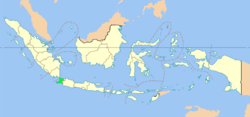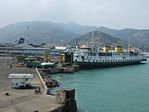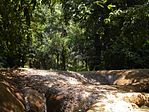Banten
From Wikipedia, the free encyclopedia
| Banten | |||||||||
|---|---|---|---|---|---|---|---|---|---|
| Province | |||||||||
Clockwise, from top left : Coast of Banten at Labuan, Ujung Kulon National Park, Puloampel in Serang, Liwungan Island, Tanjung Lesung, Carita Beach, Port of Merak
|
|||||||||
|
|||||||||
| Motto: Iman Taqwa (Faith and Piety) |
|||||||||
 Location of Banten in Indonesia |
|||||||||
| Coordinates: 6°30′S 106°15′ECoordinates: 6°30′S 106°15′E | |||||||||
| Country | |||||||||
| Established | October 4, 2000 | ||||||||
| Capital | |||||||||
| Government | |||||||||
| • Body | Banten Regional Government | ||||||||
| • Governor | Rano Karno [1] (PDI-P) | ||||||||
| • Vice Governor | Vacant | ||||||||
| Area | |||||||||
| • Total | 9,662.92 km2 (3,730.87 sq mi) | ||||||||
| Population (2014) | |||||||||
| • Total | 11,834,087 | ||||||||
| • Rank | 5th | ||||||||
| • Density | 1,200/km2 (3,200/sq mi) | ||||||||
| Demographics | |||||||||
| • Ethnic groups | Bantenese (47%), Sundanese (23%), Javanese (12%), Betawi (10%), Chinese (5%)[2] | ||||||||
| • Religion | Islam (91.64%), Christian (4.4%), Buddhism (1.2%), Confucianism (0.03%), Hindu (0.05%)[citation needed] | ||||||||
| • Languages | Indonesian (official), Sundanese (lingua franca), Javanese, Hakka, Betawi | ||||||||
| Time zone | Indonesia Western Time (UTC+7) | ||||||||
| Postcodes | 10xxx, 40xxx, | ||||||||
| Area codes | (62)2xx | ||||||||
| ISO 3166 code | ID-BT | ||||||||
| Vehicle registration | A (Main), B (Partially) | ||||||||
| GRP per capita | US$ 3,114 | ||||||||
| GRP rank | 14th | ||||||||
| HDI | |||||||||
| HDI rank | 8th | ||||||||
| Largest city by area | Serang - 266.71 square kilometres (102.98 sq mi) | ||||||||
| Largest city by population | Tangerang - (1,798,601 - 2010) | ||||||||
| Largest regency by area | Lebak Regency - 3,426.56 square kilometres (1,323.00 sq mi) | ||||||||
| Largest regency by population | Tangerang Regency - (2,781,428 - 2010) | ||||||||
| Website | Government official site | ||||||||
The population of Banten was officially estimated at 11,834,087 at the start of 2014, up from over 10.6 million during the 2010 census.[3] Formerly part of the province of West Java, Banten became a separate province in 2000. The province is a transit corridor to the neighbouring Indonesian island of Sumatra.
Historically, it has had a culture distinct from the rest of Java and that of the broader Indonesian archipelago. In recent years, the northern half, particularly those areas near Jakarta and the Java Sea coast, have experienced rapid rises in population and urbanization, while the southern half, particularly that facing the Indian Ocean, maintains more of its traditional character.
Contents
History
Banten City, year 1724
According to the Portuguese explorer, Tome Pires, in the early 16th century the port of Bantam (Banten) was an important port within the Kingdom of Sunda along with the ports of Pontang, Cheguide (Cigede), Tangaram (Tangerang), Calapa (Sunda Kelapa) and Chimanuk (estuarine of Cimanuk river).[5]
Sultanate of Banten
In 1527, just as the Portuguese fleet was arriving off the coast, newly converted Javanese Muslims under Sunan Gunungjati captured the port of Banten and the surrounding area from the Sundanese leaders and established the Sultanate of Banten. The center of this sultanate, according to J. de Barros, was Banten which was a major port in Southeast Asia rivaling Malacca and Makassar. The city of Banten was located in middle of the bay which is around three miles across. The city was 850 fathoms in length while the seaside town was 400 fathoms in length. Through the middle of town there was a clear river which ships and gale junks could sail into. There is a small tributary of the river extending to the edges of the town. Today, the river is not so large and only small boats can enter. There was a fortress very near to the town whose walls were made of brick and was seven palms wide. There were wooden defense buildings consisting of two levels and armed with good weapons. The middle of the town square was used for military activities and folk art, and as a market in the morning. The king's palace was located on the southern side of the square. Beside the building was an elevated and flat-roofed, called Srimanganti, which was used by the king when meeting the people. To the west of the square was a great mosque.In the early 17th century, Banten was an important commercial center on international trade routes in Asia. At the time, the administration and governance of port were very supportive of economic growth. Its territory included the area which is now the province of Lampung in southern Sumatra.
When the Dutch arrived in Indonesia the Portuguese had long been in Banten. The English established a representative site in Banten, a "factory", and were followed by the Dutch. In addition, the French and Danes also came to trade in Banten. In the ensuring competition between the European traders, the Dutch emerged as the winners. The Portuguese fled Banten in (1601) after their fleet was destroyed by the Dutch fleet off the coast of Banten. While the coastal areas of Banten came under Dutch influence, the sultanate kept control over the inland region until 1813. In that year, the sultanate was abolished and transformed into a residency of the Dutch East Indies.[6]
Province of Banten
After Indonesia became independent, Banten was absorbed into the province of West Java. However, separatist sentiment ultimately led to the creation of the province of Banten in 2000.[6]Geography
Banten lies between 5°7'50" and 7°1'11" south latitude and 105°1'11" and 106°7'12" east longitude.[7] The province has an area of 9,662.92 km².[8]Banten is located near the Sunda Strait's strategic sea lanes that link Australia and New Zealand with Southeast Asia, for example Thailand, Malaysia, and Singapore. In addition, Banten is the link between Java and Sumatra. When linked to the geographical position, and then the government of Banten, especially highways Tangerang (Tangerang City, Tangerang and South Tangerang City) is a buffer area for Jakarta. Economically Banten region has many industries. Banten Province also had some sea port developed in anticipation to capture the excess capacity of the seaport in Jakarta, and is intended to be an alternative to the port of Singapore.
Located on the western tip of Java makes Banten as the gateway to Java and Sumatra and the adjacent areas of Jakarta which is the capital of the State. Geostrategic position is certainly cause Banten as the main liaison trade lanes Sumatra - Java even as part of a circulation of Asian and international trade as well as the location of agglomeration economies and potential settlements. Limit northern region bordering the Java Sea, west of the Sunda Strait, as well as in the southern part of the Indian Ocean, so the area has a potential marine resources.
Topography
The topography of Banten province at an altitude ranging from 0–1000 m asl. In general topography Banten Province is low land which ranges between 0–200 m above sea level, located in the city of Cilegon, Tangerang City, Pandeglang, and most of the Serang District. The Central Lebak and Pandeglang fraction has a height ranging from 201–2000 m asl and East Lebak area has an altitude 501–2000 m asl located at the summit of Mount Sanggabuana and Mount Halimun.The topography of a region associated with the surface expression shape or morphology region. Morphology Banten region is generally divided into three groups: the morphology of the plains, hills sloping to moderate (low-medium wavy) and steep hills.
Lowland Morphology are generally found in the northern and southern portion. Plains region is a region which has a height of less than 50 meters asl (above sea level) to the coastal areas which have a height of 0–1 m above sea level. Low Hills Morphology - Medium largely occupied the central part of the study area. Hilly region located in areas that have a minimum height of 50 m above sea level. In the north of the city of Cilegon contained the peak of Mount Gede area that has the level of a maximum of 553 m above sea level, while there are hills in Serang District and the southern region of the District Mancak Waringin Kurung and Pandeglang Regency hilly areas are in the south. In Lebak there are hills in the east bordering Bogor and Sukabumi to the characteristics of lithology lithologic unit occupied by the old sediments intruded by igneous rocks in igneous rocks such as granite, granodiorite, diorite and andesite. Usually the area around the igneous rocks occur terobosaan remineralization process containing a very economical value such as tin and copper ore deposits.
Climate
Climate in the Banten region is strongly influenced by Monsoon wind and La Nina or El Nino Wave . When the rainy season (November - March) the weather is dominated by the West wind (of Sumatra, the Indian Ocean south of India) are joined by winds from Asia passing through the South China Sea. August), the weather is dominated by the East wind which causes Banten harsh drought, especially in the northern part of the coast, especially when ongoing El Nino. Temperatures in coastal areas and hills ranging between 22 °C and 32 °C, while the temperature in the mountains with an altitude of between 400 –1350 m above sea level at between 18 °C -29 °C.The highest rainfall of 2712–3670 mm in the rainy season months of September to May cover 50% area of Pandeglang west and rainfall 335–453 mm in the month from September to May cover 50% area of Serang Regency North, the entire area of the city of Cilegon, 50% area of Tangerang regency north and the entire area of the city of Tangerang. In the dry season, the highest rainfall of 615–833 mm in April–December cover 50% area of Serang Regency north, the whole area of the city of Cilegon, 50% area of Tangerang District north and the entire area of the city of Tangerang, while the bulk the lowest rainfall in the dry season as much as 360–486 mm in the month of June to September 50% coverage area of Tangerang Regency south and 15% area of southeastern Serang District.
Administrative divisions
Banten Province is subdivided into four regencies (kabupaten) and four autonomous cities (kota), listed below with their populations at the 2000 and 2010 Censuses, together with the latest (2014) official estimates. The cities and regencies are additionally subdivided into 140 districts, 262 urban villages and 1,242 villages.| Name | Capital | Area (km2) | Population Census 2000 |
Population Census 2010 |
Population 2014 Estimate[9] |
HDI[10] 2014 Estimates |
|---|---|---|---|---|---|---|
| Cilegon (city) | 175.51 | 294,936 | 374,559 | 416,901 | 0.715 (High) | |
| Serang (city) | 266.71 | (a) | 577,785 | 643,101 | 0.702 (High) | |
| Lebak Regency | Rangkasbitung | 3,426.56 | 1,030,040 | 1,204,095 | 1,340,213 | 0.616 (Medium) |
| Pandeglang Regency | Pandeglang | 2,746.89 | 1,011,788 | 1,149,610 | 1,279,569 | 0.620 (Medium) |
| Serang Regency | Ciruas | 1,734.28 | 1,652,763 | 1,402,818 | 1,561,401 | 0.639 (Medium) |
| Western Banten totals (outside Jabodetabek) |
8,349.95 | 3,989,527 | 4,708,867 | 5,241,185 | ||
| South Tangerang (city) | 147.19 | (b) | 1,290,322 | 1,436,187 | 0.791 (High) | |
| Tangerang (city) | 153.93 | 1,325,854 | 1,798,601 | 2,001,925 | 0.758 (High) | |
| Tangerang Regency | Tigaraksa | 1,011.86 | 2,781,428 | 2,834,376 | 3,154,790 | 0.695 (Medium) |
| Eastern Banten totals (within Jabodetabek) |
1,312.98 | 4,107,282 | 5,923,299 | 6,592,902 | ||
| Banten totals | 9,662.93 | 8,096,809 | 10,632,166 | 11,834,087 | 0.698 (Medium) | |
- (a) The 2000 Census population for Serang city is included in the figure for Serang Regency.
- (b) The 2000 Census population for South Tangerang city is included in the figure for Tangerang Regency.
- Tangerang City was incorporated as an autonomous city on 27 February 1993 out of the Tangerang Regency, in which it previously served as administrative capital. It was subsequently replaced by Cipasera (see below).
- Cilegon City was incorporated as an autonomous city on 10 April 1999 out of the Serang Regency, in which it previously served as administrative capital. It was subsequently replaced by Serang (see below).
- Serang City was incorporated as an autonomous city in November 2007 out of the Serang Regency, in which it previously served as administrative capital. It was subsequently replaced by Ciruas.
- South Tangerang City (formerly Cipasera) was incorporated as an autonomous city on 29 October 2008 out of the Tangerang Regency. in which it previously served as administrative capital. It was subsequently replaced by Tigaraksa.
Culture and values
Most people in Banten embrace Islam with religious fervor is high, but other religions can coexist peacefully.Potential community and cultural distinctiveness of Banten, among other martial art Pencak Silat, Debus, Rudad, Umbruk, Saman Dance, Mask Dance, Dance Cokek, Dog-dog, Palingtung, and Lojor. In addition, there is also a relic of the heritage include Great Mosque of Banten Lama, Makam Keramat Lama, and many other relics.
In Banten lives the Baduy people. The Baduy are the original Sundanese people who still maintain the tradition of anti-modernization, both how to dress or other living patterns. The Baduy-Rawayan living in the Kendeng Mountains Heritage area of 5101.85 hectares in Kanekes, Leuwidamar subdistrict, Lebak. Baduy villages are generally located in the Ciujung River basin n Kendeng Mountains. This area is known as the area of land inherited from ancestors, which must be maintained, and should not be tampered with.
Languages
The natives who live in Banten Province speak a dialect which is derived from the Old Sundanese language. Dialect is classified as coarse language in modern Sundanese language, which has several levels of the level of fine to coarse level (informal), which was first created in the Sultanate of Mataram occupied Priangan (the eastern part of West Java province). However, in the southern part of Banten such as Lebak and Pandeglang, the local people use of Archaic Sundanese, Modern Sundanese, and Indonesian.; While in the northern part of Banten such as Serang and Cilegon, the local people tend to use the Javanese language as there are many Javanese migrants there. In the northern part of the city of Tangerang, Betawi is also used by Betawi immigrants. In addition to the Sundanese, Javanese and Betawi, Indonesian also used primarily by migrants from other parts of Indonesia.Traditional weapon
Golok is the traditional weapon in Banten which is the same as the traditional weapon of the Special Capital Region of Jakarta.Traditional house
The traditional house in Banten called Rumag Panggung with roof thatching, and the floor is made of pounded bamboos split. While the walls were made from the booth (gedek). To buffer stage house is a stone that has been created in such a way that ends shaped beam decreasing as the stone used for pounding rice pedestal. The traditional house is still widely found in areas inhabited by the Kanekes People or the Baduy.List of governors
At the time of the formation of Banten Province, Djamal Hakamudin was appointed as the first governor by the Indonesian central government. In 2002, the Banten provincial parliament (Dewan Perwakilan Rakyat Daerah or DPRD) chose Djoko Munandar and Ratu Atut Chosiyah as governor and deputy governor of Banten respectively. In early 2006, after Djoko Munandar was suspended during an investigation into alleged corruption, Ratu Atut Chosiyah was appointed as acting governor . Finally, on 6 December 2006, a provincial election was held which was won by Ratu Atut Choisiyah as governor and Mohammad Masduki as deputy governor; both served in the period 2007-2011.| Name[11] | Position | Took office | Left office | Information |
|---|---|---|---|---|
| Hakamudin Djamal | Acting Governor | 2000 | 2002 | |
| Djoko Munandar | Governor | 2002 | 2005 | Removed on charges of corruption |
| Ratu Atut Chosiyah | Acting governor | 2005 | 2007 | |
| Ratu Atut Chosiyah | Governor | 2007 | 2012 | |
| Ratu Atut Chosiyah | Governor | 2012 | 2015 | Dismissed for bribery |
| Rano Karno | Acting Governor | 2014 | 2015 | |
| Rano Karno | Governor | 2015 | Incumbent | Starting on 12 August 2015 |
Transport
Banten is located in the most western tip of Java island has a very strategic position, and has a huge economic potential either for local, regional, national, and even international scale. Facilitation of the movement of goods and passengers from and to the activity centers of national, regional and local level in the province of Banten became very important in the effort to support economic development in the province of Banten.Banten province is divided into three Areas of Work Development that has an icon or characteristic of communications facilities in the province of Banten, as the activity is more pronounced than with other transportation infrastructure.
- Work Area I, namely the city of Tangerang and Tangerang regency. Inside are Soekarno-Hatta International Airport which is the gateway entry of goods and passengers by air transport to Indonesia.
- Work Area II, the city of Cilegon and Serang District. Inside are the Port of Merak gateway entry of goods and passengers from the island of Sumatra to Java.
- Work Area III, which Pandeglang and Lebak. Inside are several railway Station which is the entrance of goods and passengers, especially from and to Jakarta.










Tidak ada komentar:
Posting Komentar